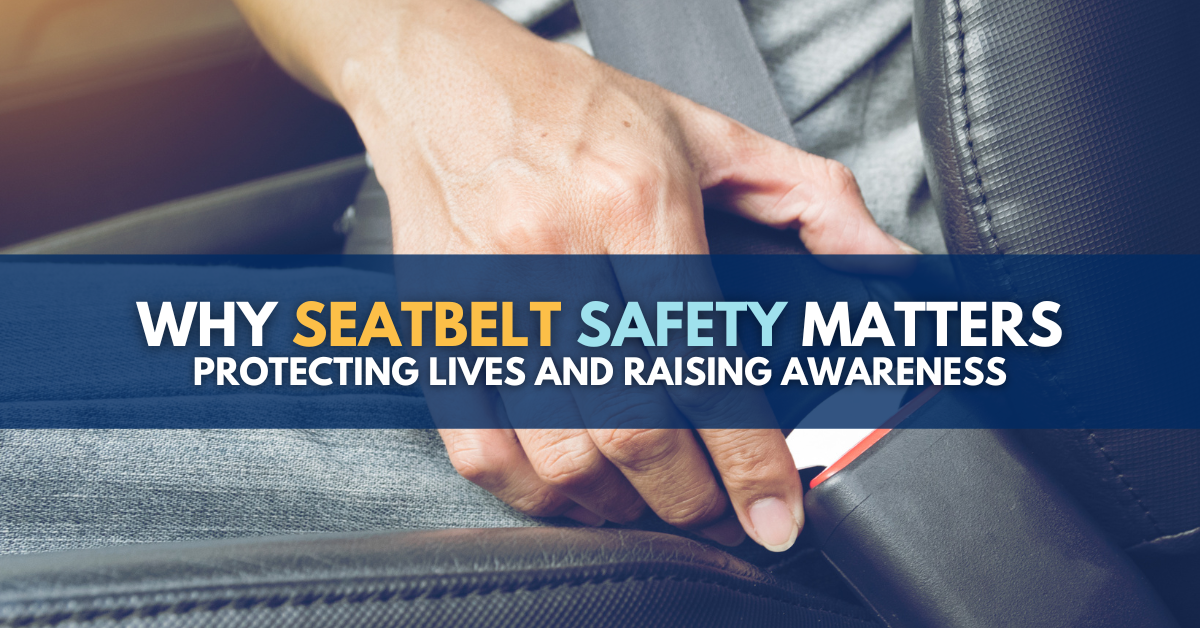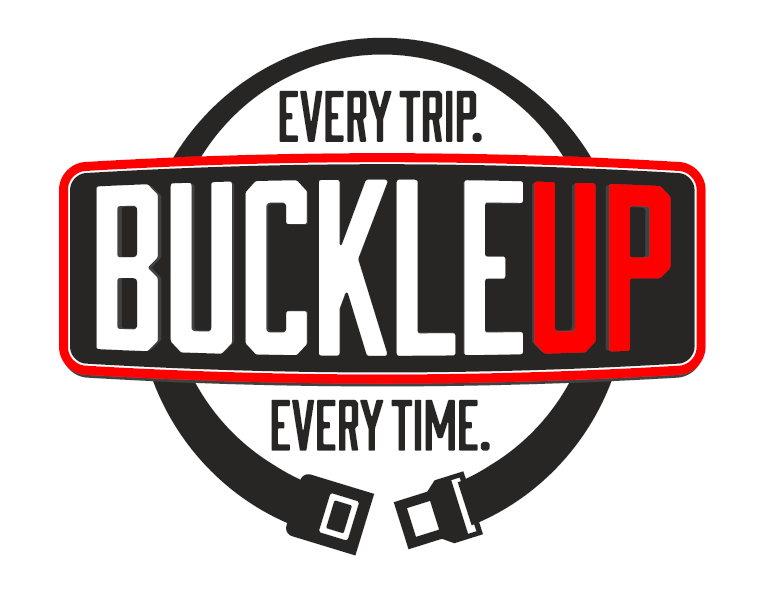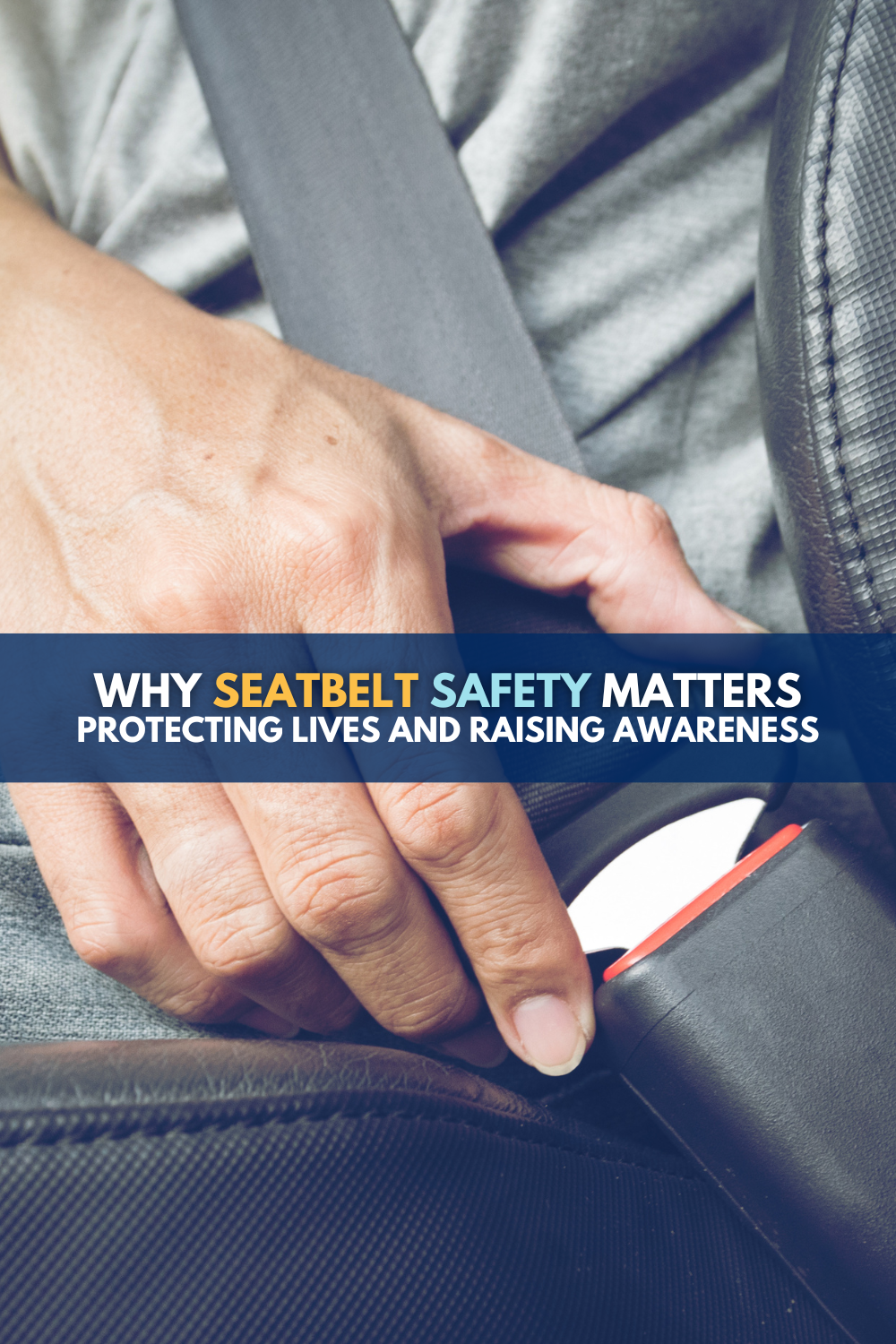Seatbelt Safety Guide: Protecting Lives and Raising Awareness

Introduction
National Seatbelt Safety Day, observed every November 14th, commemorates the invention of the three-point seatbelt in 1959 and urges seatbelt use. Initiated in 2019 by the GHSA, Uber, and Volvo, this day emphasizes the life-saving potential of seatbelts, encouraging all vehicle occupants to buckle up and reduce accident-related injuries and fatalities.
Seatbelts are crucial safety devices that secure passengers during sudden stops or collisions, reducing injury risk by 50% and fatalities by 45%. Not wearing seatbelts can result in costly tickets and impact insurance premiums.
Despite misconceptions and resistance, seatbelt use has increased, with a 2021 nationwide rate of 90.4%. National Seatbelt Safety Day dispels myths and underscores the importance of seatbelt use concisely and readably [1]
Why Seatbelt Safety Matters
Seatbelt safety is a critical aspect of road safety that cannot be overstated. Seatbelts are the most effective defense against impaired, aggressive, and distracted drivers. They play a crucial role in ensuring the safety of vehicle occupants during a crash by keeping them secure inside the vehicle. The risk of being completely ejected from a vehicle, which is almost always fatal, is significantly reduced when seatbelts are worn. According to the National Highway Traffic Safety Administration (NHTSA), using lap and shoulder seat belts can reduce the risk of front-seat passenger car occupant deaths by 45% and moderate to critical injuries by 50%.[2]
The importance of seatbelt safety is further emphasized by the fact that not wearing a seatbelt can have severe consequences. For instance, if you don’t wear your seat belt, you could be thrown into a rapidly opening frontal air bag, which could injure or even kill you. Moreover, people not wearing a seat belt are 30 times more likely to be ejected from a vehicle during a crash. More than 3 out of 4 people who are ejected during a fatal crash die from their injuries. Therefore, National Seatbelt Safety Day, observed annually on November 14th, serves as a vital reminder for everyone to buckle up, not just for their own safety but also for the safety of others on the road.
Seatbelt Usage Statistics
The national estimate of seat belt use by adult front-seat passengers in 2022 was 91.6%, marking a record high. This figure, however, was not statistically different from the 90.4% observed in 2021[3]. In 2021, about 50% of the 26,325 passenger vehicle occupants killed were not buckled up. Seat belts saved an estimated 14,955 lives that year and could have saved an additional 2,549 people if they had been wearing seat belts.
Despite these promising figures, it’s important to note that more than 46,000 people are killed in car accidents in the U.S. every year, and an estimated 4.4 million people sustain injuries that require medical attention. Therefore, the observance of National Seatbelt Safety Day serves as a critical reminder of the life-saving importance of wearing seat belts.
Other Important Seat Belt Statistics
1. Seat Belt Usage Rates:
In the United States, the overall seat belt usage rate was approximately 90% for drivers and front-seat passengers in 2020, according to the National Highway Traffic Safety Administration (NHTSA).
2. Seat Belts Save Lives:
Seat belts are estimated to save over 15,000 lives in the United States each year, according to NHTSA data.
3. Effectiveness in Reducing Fatalities:
According to the World Health Organization (WHO), wearing a seat belt can reduce the risk of death in a crash by up to 50% for front-seat passengers and drivers.
4. Non-Usage in Fatal Crashes:
In the United States, in 2019, nearly half (47%) of the occupants killed in car crashes were not wearing seat belts, as reported by NHTSA.

Types of Seatbelts
There are several types of seatbelts used in vehicles, each designed to protect occupants in different ways[4]:
Lap Belt: This type of seatbelt is commonly seen in airplanes and older vehicles. It is attached at two points over a person’s lap, providing basic restraint that prevents the occupant from being ejected during a crash.
Sash/Shoulder Belt: The sash or shoulder belt lays diagonally across a person’s body, similar to a sash. These types of seatbelts typically buckle toward the center of the vehicle, providing additional upper body restraint.
3-Point/Y-Shaped Belt: First introduced in 1959, the three-point harness combines the lap and shoulder belt into one. This design spreads the force of a collision over a wider area of the body, reducing the stress on any one area and providing more comprehensive protection.
Belt-in-Seat: This is another type of 3-point seatbelt. However, it is attached to the seat rather than the support column of the vehicle, providing a similar level of protection as the standard 3-point belt but with a different attachment point.
5-Point Seatbelt: This type of seatbelt usually buckles in the center and includes two shoulder belts, a lap belt, and an additional belt between the legs. While not commonly found in vehicles, five-point belts are often used in race cars and child safety seats for their enhanced safety features.
Proper Seatbelt Use
It’s not enough to just wear a seat belt; it must be worn correctly for maximum effectiveness. The lap belt should be worn low across the hips and below the stomach, while the shoulder belt should be worn over the collarbone. The shoulder belt should be away from your neck and across your chest, and any slack from your seat belt should be removed with the lap belt secured snugly across your hips and pelvic bone.
Non-compliance with seat belt laws comes with penalties, including fines and penalty points. More importantly, not wearing a seat belt can result in severe consequences such as head trauma, traumatic brain injuries, neck and spinal cord injuries, and internal injuries. On National Seatbelt Safety Day, let’s remember to buckle up every time we get into a vehicle, whether as a driver or a passenger, and encourage others to do the same[5].
Common Myths and Misconceptions
Despite the proven safety benefits of wearing a seatbelt, there are still several misconceptions that persist among some individuals. One common myth is that there’s no need to wear a seatbelt if you aren’t driving far or fast. However, statistics from the National Highway Traffic Safety Administration (NHTSA) reveal that most fatal accidents occur within 25 miles from home and may involve speeds of less than 25 mph, debunking this misconception.
Another prevalent myth is that airbags eliminate the need for seatbelts. This is incorrect as airbags are designed to protect a buckled person, not an unbuckled one. In a crash, seatbelts hold a person in place and in the proper position for when an airbag deploys. Without a seatbelt, a person could slide under the wheel or be thrown out the front windshield, making the airbag ineffective.
Lastly, some people believe that seatbelts can trap you in your car during a crash. This fear often stems from crashes involving fire or water, which only account for 0.5% of all wrecks. In reality, seatbelts prevent you from being knocked unconscious, increasing your chances of escaping after a crash.
Michigan Seatbelt Laws and Regulations
Seatbelt laws and regulations are crucial for ensuring the safety of vehicle occupants. Here are ten important points to note[6]:
- Michigan has a primary law, which means law enforcement can stop and ticket motorists solely for not being buckled up.
- Passengers 8-15 years old must wear a seat belt in all seating positions. Drivers and front seat passengers must be buckled.
- The shoulder belt should fit snugly over the shoulder with the lap belt low on hips. Improperly wearing a seat belt, such as putting the strap below your arm or behind your back, is illegal.
- Fine amounts vary by area but generally are about $65 for a seat belt ticket.
- Children must ride in a car seat until they reach the height and weight capacity of the seat.
- Children must be properly buckled in a car seat or booster seat until they are 8 years-old or 4 feet, 9 inches tall, whichever comes first.
- Children younger than age 4 must ride in a car seat in the rear seat if the vehicle has a rear seat.
- If all available rear seats are occupied by children under 4, then a child under 4 may ride in a car seat in the front seat.
- A child in a rear-facing car seat may only ride in the front seat if the airbag is turned off.
- Fine amounts vary by area but generally are about $120 for child safety seat violations.
Real-life Stories
Seat belts have been proven to be lifesavers in numerous real-life incidents. In the “Seat Belt Stories” series by the Colorado Department of Transportation (CDOT), there are several tragic accounts of individuals who lost their lives in car accidents due to not wearing seatbelts. One such story is about Amy and Christy, two mothers who lost their children in unbuckled crashes. Amy’s oldest son, Brandon, was involved in a crash in the mountains over 15 years ago. He and the front-seat passenger were not wearing seatbelts and did not survive the accident. The three passengers in the back seat, however, were buckled up and walked away uninjured[7].
Similarly, Christy lost her daughter, Sammie, in July 2020. Sammie was not wearing her seatbelt in the back seat and was ejected from the vehicle during the crash. The driver and the front-seat passenger, wearing seatbelts, survived the accident without any injuries[7].
Another heartbreaking story is that of Hannah, who, at the age of 4, lost her mother to a seat belt-related crash. Her mother was driving on Colorado Highway 52 east without wearing a seatbelt. When the cars in front of her began to stop, she couldn’t brake quickly enough and rolled her car multiple times. She was ejected from the car and did not survive. Hannah, however, was properly restrained in her car seat and survived the crash with no injuries[7].
These stories underscore the critical importance of wearing seat belts while driving or riding in a vehicle. They have saved countless lives by preventing passengers from being ejected during accidents and reducing the impact of crashes.
The Economic Impact of Seatbelt Safety
Seatbelt safety has a profound economic impact, saving billions of dollars annually in the United States alone. The use of seatbelts is not just a matter of personal safety but also a significant economic concern. It is estimated that the total cost savings in the United States due to seatbelt usage is $74.4 billion, with $21.6 billion coming from states that do not have a primary seatbelt law.[8]
The financial implications of seatbelt safety are substantial. Non-use of seatbelts results in needless deaths and injuries, costing society an estimated $26 billion annually. On the other hand, seatbelt use saves approximately $50 billion each year in medical care, lost productivity, and other injury-related expenses. These figures underscore the economic benefits of seatbelt safety, which extend beyond individual users to society at large[9].
A study conducted in Kansas demonstrated the economic benefits of increased seatbelt use. According to the study, seatbelts are 56% effective in preventing fatal injuries for passenger car front seat occupants and 61% effective for other passenger vehicles, including vans and pickups. The study also found that a 1% increase in current seatbelt usage could save about $14 million annually for the state of Kansas. If seatbelt usage in Kansas reaches the national average rate of 82%, the expected annual economic savings could be around $222 million[10].
Child Seatbelt Safety
Child seatbelt safety is essential for protecting young passengers during car rides. It significantly reduces injury and fatality risks during crashes[11]. Children must be secured in the right seat based on their age and size. Typically, kids need booster seats until they’re about 4 feet 9 inches tall and 8 to 12 years old. Most children won’t fit in a regular seat belt alone until they’re 10 to 12 years old.
Seat belts play a crucial role in preventing ejection from the vehicle, managing collision forces, and protecting from interior collisions. For children, proper car seats or booster seats can reduce injuries and deaths by up to 80%. Ensuring child seatbelt safety includes making sure seat belts fit correctly and comfortably. Ill-fitting belts may encourage kids to unbuckle, creating risks.
Parents and caregivers should educate children on seat belt importance through age-appropriate discussions and activities. Positive reinforcement and rewards can encourage consistent seatbelt use. Non-compliance with child passenger safety laws can lead to severe consequences, including fines ranging from $10 to $500 in some states[12].
Seatbelt Safety Campaigns
Seatbelt safety campaigns, like FMCSA’s “Y I Buckle Up” and NHTSA’s “Click It or Ticket,” raise awareness about seatbelt benefits and compliance with the law. “Y I Buckle Up” highlights protection and legal compliance, while “Click It or Ticket” focuses on education, strong laws, and enforcement to save lives. Statistics show that seatbelts saved 14,955 lives in 2017, reducing death risk by 45% and injuries by 50%.
Media and enforcement campaigns, even in states with secondary seatbelt laws, effectively increase usage rates. These campaigns also stress the legal consequences of non-compliance, with one person per seat fitted with a seatbelt and potential fines or license suspension for non-compliance.
National Seatbelt Safety Day Initiatives
National Seatbelt Safety Day, observed annually on November 14th, is a vital event dedicated to encouraging seatbelt usage, particularly during the holiday season, a period associated with increased road travel and accidents. Key to its success are initiatives like the “Click It or Ticket” campaign by the NHTSA, which educates on seatbelt importance and legal consequences.
These campaigns significantly increased seatbelt usage, saving lives and reducing injuries. Educational programs and online resources complement these efforts by informing the public about seatbelt use and dispelling misconceptions. However, the ultimate responsibility for compliance rests with each individual, emphasizing the importance of wearing seatbelts every day for personal safety.
Table of Contents
- Introduction
- Why Seatbelt Safety Matters
- Seatbelt Usage Statistics
- Types of Seatbelts
- Proper Seatbelt Use
- Common Myths and Misconceptions
- Michigan Seatbelt Laws and Regulations
- Real-life Stories
- The Economic Impact of Seatbelt Safety
- Child Seatbelt Safety
- Seatbelt Safety Campaigns
- National Seatbelt Safety Day Initiatives






